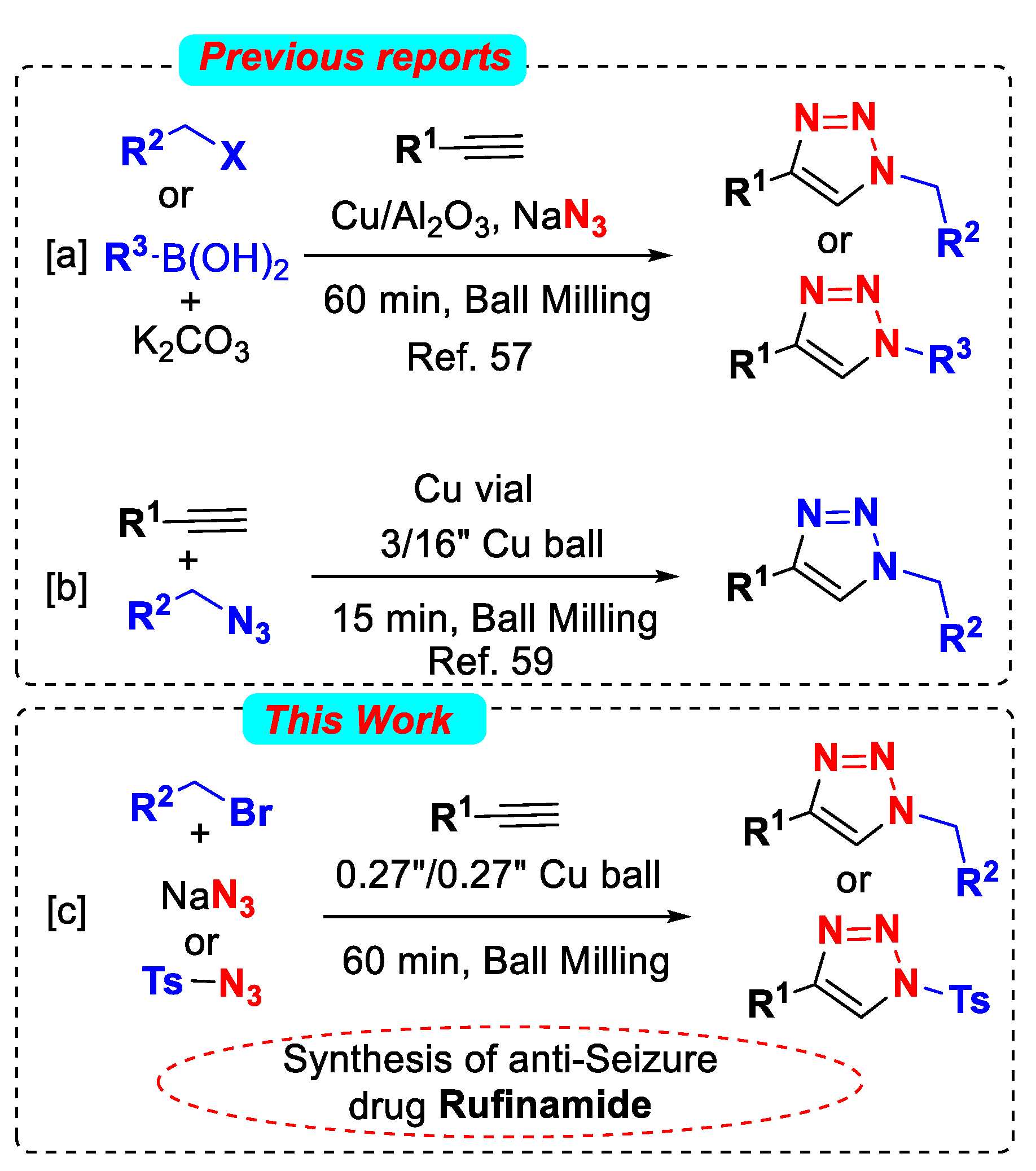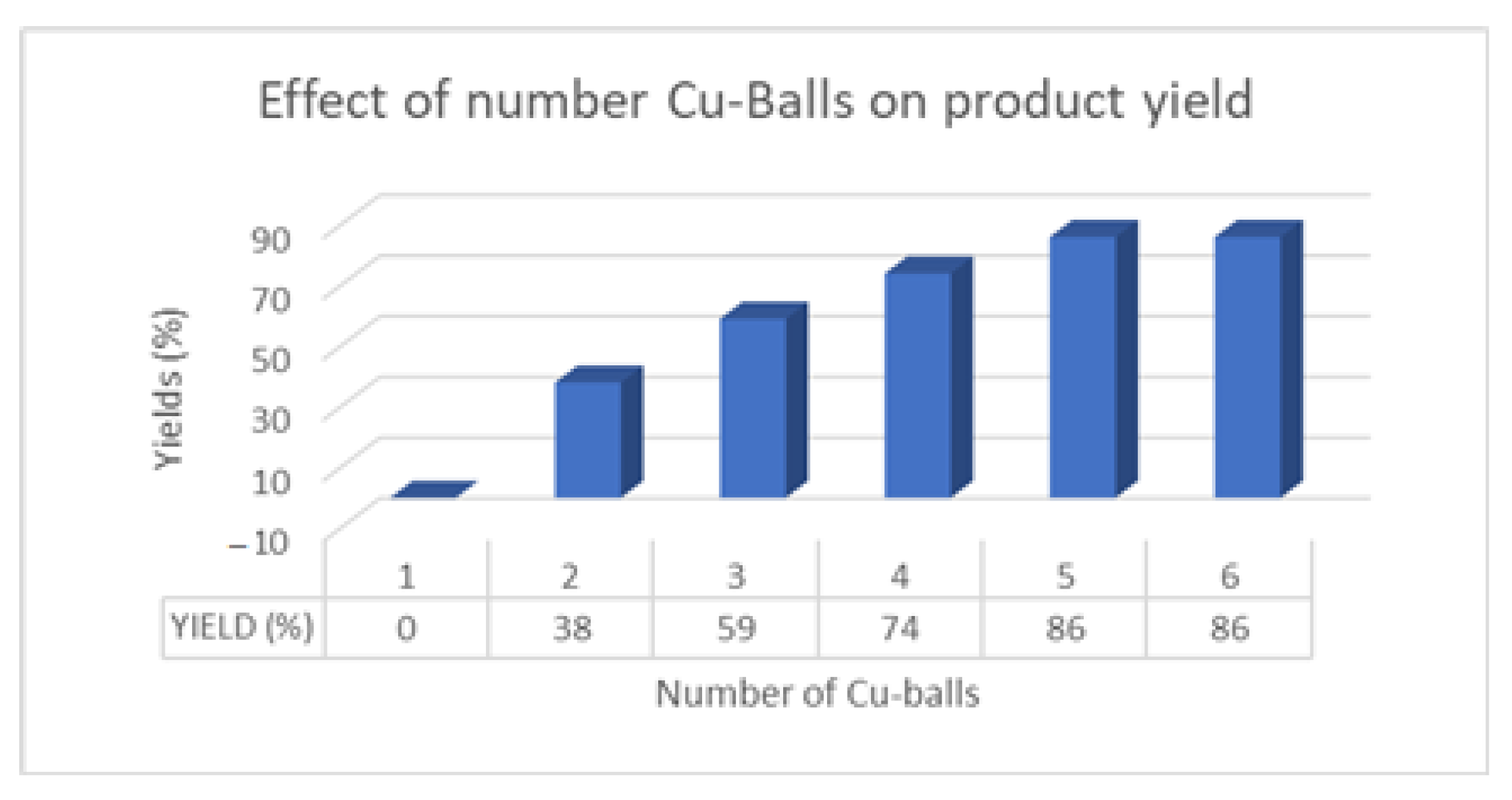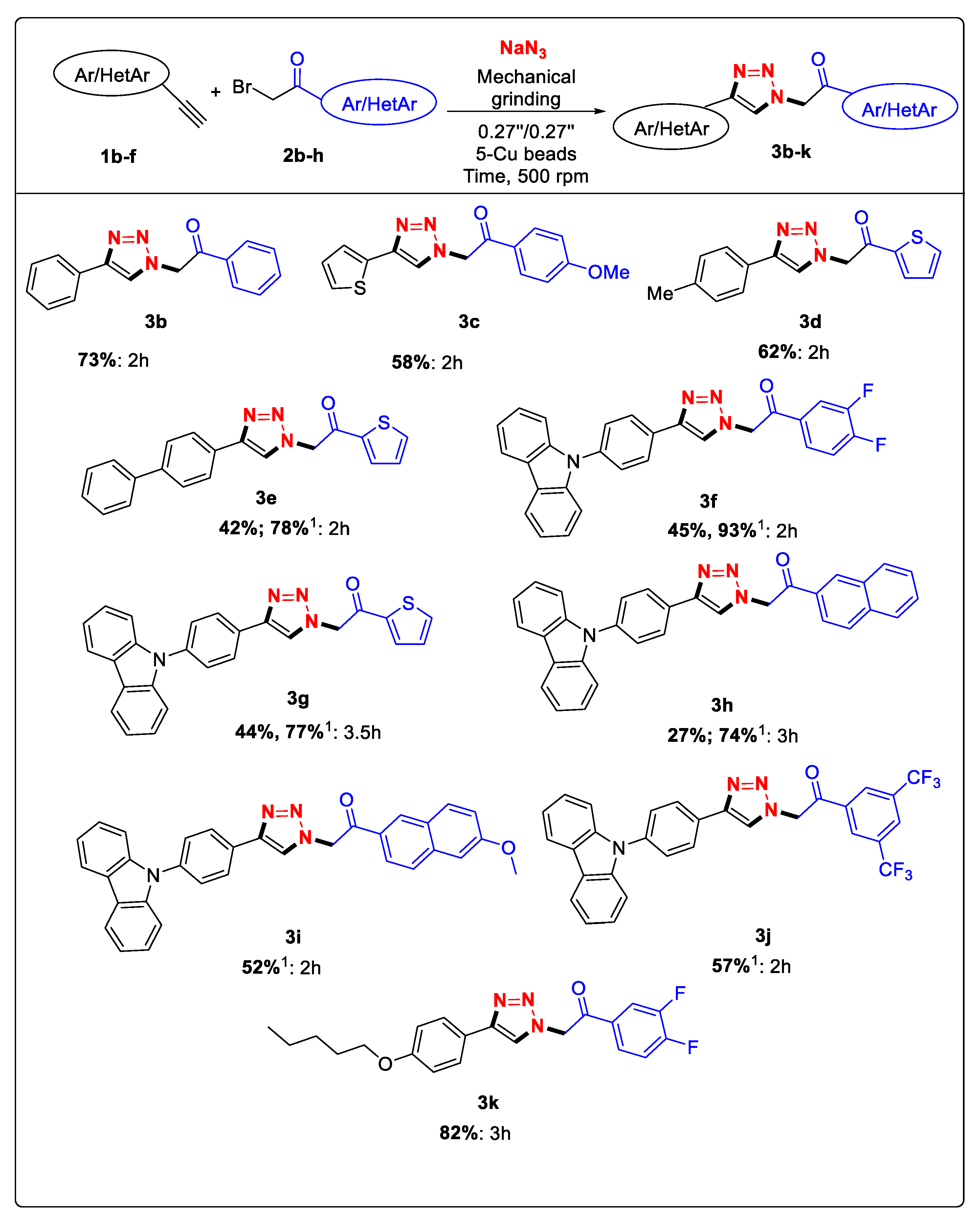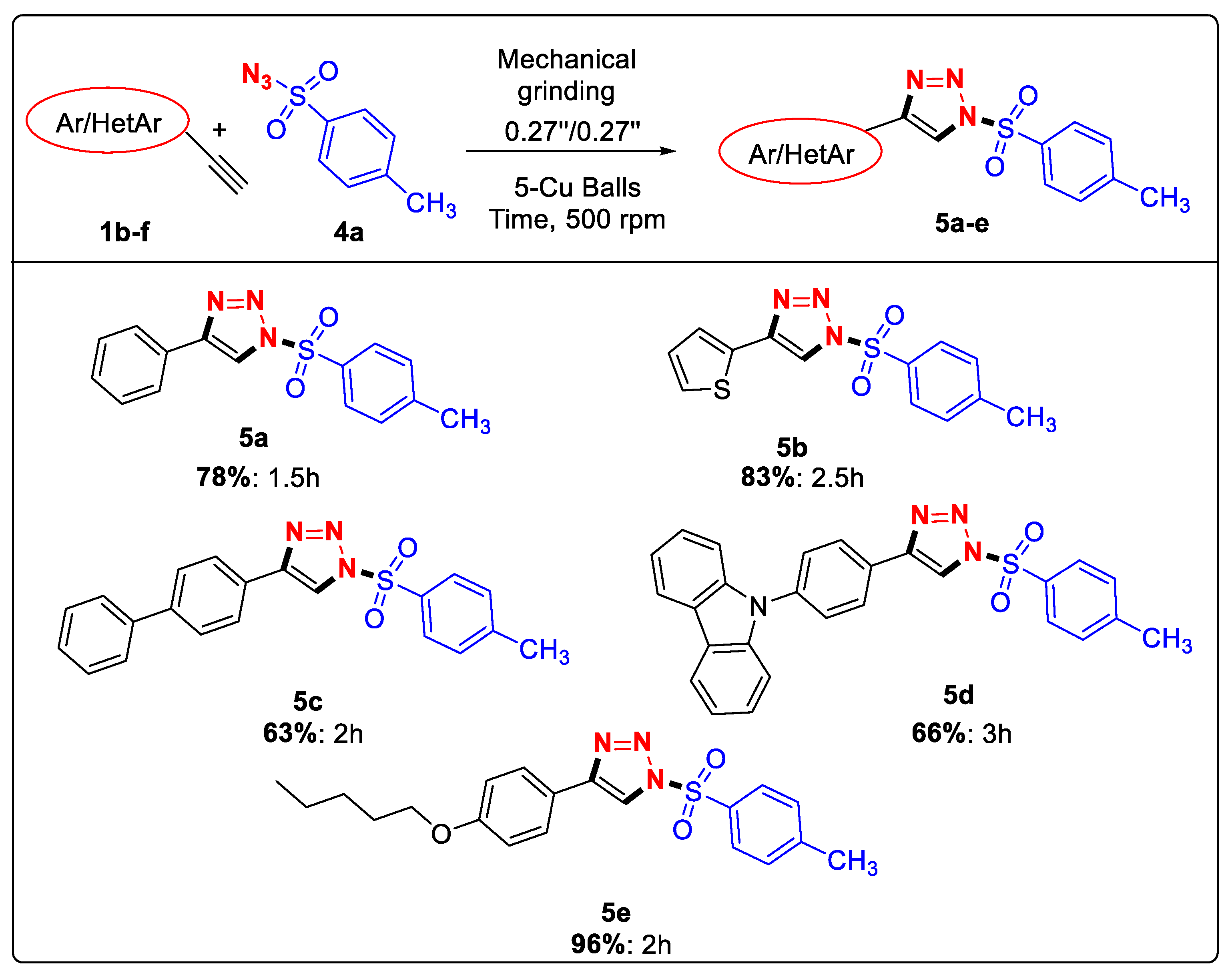Mechanochemical Approach towards Multi-Functionalized 1,2,3-Triazoles and Anti-Seizure Drug Rufinamide Analogs Using Copper Beads
Abstract
:1. Introduction
2. Results and Discussion
Plausible Catalytic Pathway
3. Conclusions
4. Experimental Section
Supplementary Materials
Author Contributions
Funding
Institutional Review Board Statement
Informed Consent Statement
Data Availability Statement
Conflicts of Interest
References
- Whiting, M.; Muldoon, J.; Lin, Y.-C.; Silverman, S.M.; Lindstrom, W.; Olson, A.J.; Kolb, H.C.; Finn, M.G.; Sharpless, K.B.; Elder, J.H.; et al. Inhibitors of HIV-1 Protease by Using In Situ Click Chemistry. Angew. Chem. Int. Ed. 2006, 45, 1435–1439. [Google Scholar] [CrossRef] [PubMed]
- Kolb, H.C.; Sharpless, K.B. The growing impact of click chemistry on drug discovery. Drug Discov. Today 2003, 8, 1128–1137. [Google Scholar] [CrossRef]
- Giffin, M.J.; Heaslet, H.; Brik, A.; Lin, Y.C.; Cauvi, G.; Wong, C.-H.; McRee, D.E.; Elder, J.H.; Stout, C.D.; Torbett, B.E. A Copper(I)-Catalyzed 1,2,3-Triazole Azide−Alkyne Click Compound Is a Potent Inhibitor of a Multidrug-Resistant HIV-1 Protease Variant. J. Med. Chem. 2008, 51, 6263–6270. [Google Scholar] [CrossRef]
- Fann, W.-Q.; Katritzky, A.R. Comprehensive Heterocyclic Chemistry, 2nd ed.; Katritzky, A.R., Rees, C.W., Scriven, E.F.V., Eds.; Elsevier Science: Oxford, UK, 1996; Volume 4, p. 1. [Google Scholar]
- Xiong, X.; Tang, Z.; Sun, Z.; Meng, X.; Song, S.; Quan, Z. Supported copper (I) catalyst from fish bone waste: An efficient, green and reusable catalyst for the click reaction toward N-substituted 1,2,3-triazoles. Appl. Organomet. Chem. 2018, 32, e3946. [Google Scholar] [CrossRef]
- Yadav, P.; Lal, K.; Kumar, A.; Guru, S.K.; Jaglan, S.; Bhushan, S. Green synthesis and anticancer potential of chalcone linked-1,2,3-triazoles. Eur. J. Med. Chem. 2017, 126, 944–953. [Google Scholar] [CrossRef]
- Joy, M.N.; Bodke, Y.D.; Telkar, S.; Bakulev, V.A. Synthesis of Coumarins Linked With 1,2,3-Triazoles under Microwave Irradiation and Evaluation of their Antimicrobial and Antioxidant Activity. J. Mex. Chem. Soc. 2020, 64, 53–73. [Google Scholar] [CrossRef] [Green Version]
- Joy, M.N.; Beliaev, N.; Beryozkina, T.V.; Bakulev, V.A. Design and the synthesis of 1-heteroaryl-1,2,3-triazoles connected to coumarins via ether linker. J. Heterocycl. Chem. 2020, 57, 3173–3185. [Google Scholar] [CrossRef]
- Brockunier, L.L.; Parmee, E.R.; Ok, H.O.; Candelore, M.R.; Cascieri, M.A.; Colwell, L.F., Jr.; Deng, L.; Feeney, W.P.; Forrest, M.J.; Hom, G.J. Human β3-adrenergic receptor agonists containing 1,2,3-triazole-substituted benzenesulfonamides. Bioorganic Med. Chem. Lett. 2000, 10, 2111–2114. [Google Scholar] [CrossRef]
- Dheer, D.; Singh, V.; Shankar, R. Medicinal attributes of 1,2,3-triazoles: Current developments. Bioorganic Chem. 2017, 71, 30–54. [Google Scholar] [CrossRef]
- Ryu, E.-H.; Zhao, Y. Efficient Synthesis of Water-Soluble Calixarenes Using Click Chemistry. Org. Lett. 2005, 7, 1035–1037. [Google Scholar] [CrossRef]
- Such, G.K.; Quinn, J.F.; Quinn, A.; Tjipto, E.; Caruso, F. Assembly of Ultrathin Polymer Multilayer Films by Click Chemistry. J. Am. Chem. Soc. 2006, 128, 9318–9319. [Google Scholar] [CrossRef] [PubMed]
- Lober, S.; Rodriguez-Loaiza, P.; Gmeiner, P. Click Linker: Efficient and High-Yielding Synthesis of a New Family of SPOS Resins by 1,3-Dipolar Cycloaddition. Org. Lett. 2003, 5, 1753–1755. [Google Scholar] [CrossRef] [PubMed]
- Lutz, J.-F. 1,3-Dipolar cycloadditions of azides and alkynes: A universal ligation tool in polymer and materials science. Angew. Chem. Int. Ed. 2007, 46, 1018–1025. [Google Scholar] [CrossRef] [PubMed]
- Huisgen, R. 1,3-Dipolar Cycloadditions. Proc. Chem. Soc. 1961, 357–396. [Google Scholar] [CrossRef]
- Tornoe, C.W.; Christensen, C.; Meldal, M. Peptidotriazoles on Solid Phase: [1,2,3]-Triazoles by Regiospecific Copper(I)-Catalyzed 1,3-Dipolar Cycloadditions of Terminal Alkynes to Azides. J. Org. Chem. 2002, 67, 3057–3064. [Google Scholar] [CrossRef] [PubMed]
- Rostovtsev, V.V.; Green, L.G.; Fokin, V.V.; Sharpless, K.B. A Stepwise Huisgen Cycloaddition Process: Copper(I)-Catalyzed Regioselective “Ligation” of Azides and Terminal Alkynes. Angew. Chem. Int. Ed. 2002, 41, 2596–2599. [Google Scholar] [CrossRef]
- Meldal, M.; Tornøe, C.W. Cu-Catalyzed Azide−Alkyne Cycloaddition. Chem. Rev. 2008, 108, 2952–3015. [Google Scholar] [CrossRef]
- Tiwari, V.K.; Mishra, B.B.; Mishra, K.B.; Mishra, N.; Singh, A.S.; Chen, X. Cu-Catalyzed Click Reaction in Carbohydrate Chemistry. Chem. Rev. 2016, 116, 3086–3240. [Google Scholar] [CrossRef]
- Joy, M.N.; Beliaev, N.; Beryozkina, T.V.; Bakulev, V.A. A facile access for the synthesis of 1-hetero(aryl)-1,2,3-triazoles linked to equol under mild conditions. Synth. Commun. 2020, 50, 3086–3092. [Google Scholar] [CrossRef]
- Zhu, L.; Brassard, C.J.; Zhang, X.; Guha, P.M.; Clark, R.J. On the Mechanism of Copper(I)-Catalyzed Azide-alkyne Cycloaddition. Chem. Rec. 2016, 16, 1501–1517. [Google Scholar] [CrossRef]
- Sarkar, A.; Santra, S.; Kundu, S.K.; Hajra, A.; Zyryanov, G.V.; Chupakhin, O.N.; Charushin, V.N.; Majee, A. A decade update on solvent and catalyst-free neat organic reactions: A step forward towards sustainability. Green Chem. 2016, 18, 4475–4525. [Google Scholar] [CrossRef]
- Leonardi, M.; Villacampa, M.; Menéndez, J.C. Multicomponent mechanochemical synthesis. Chem. Sci. 2018, 9, 2042–2064. [Google Scholar] [CrossRef] [PubMed] [Green Version]
- Haldón, E.; Nicasio, M.C.; Pérez, P.J. Copper-catalysed azide-alkyne cycloadditions (CuAAC): An update. Org. Biomol. Chem. 2015, 13, 9528–9550. [Google Scholar] [CrossRef]
- Sokolova, N.V.; Nenajdenko, V.G. Recent advances in the Cu(i)-catalyzed azide-alkyne cycloaddition: Focus on functionally substituted azides and alkynes. RSC Adv. 2013, 3, 16212–16242. [Google Scholar] [CrossRef]
- Berg, R.; Straub, B.F. Advancements in the mechanistic understanding of the copper-catalyzed azide-alkyne cycloaddition. Beilstein J. Org. Chem. 2013, 9, 2715–2750. [Google Scholar] [CrossRef] [PubMed] [Green Version]
- Saini, P.; Sonika; Singh, G.; Kaur, G.; Singh, J.; Singh, H. Robust and Versatile Cu(I) metal frameworks as potential catalysts for azide-alkyne cycloaddition reactions: Review. Mol. Catal. 2021, 504, 111432. [Google Scholar] [CrossRef]
- Shil, A.K.; Kumar, S.; Sharma, S.; Chaudhary, A.; Das, P. Polystyrene resin supported palladium(0) (Pd@PR) nanocomposite mediated regioselective synthesis of 4-aryl-1-alkyl/(2-haloalkyl)-1H-1,2,3-triazoles and their N-vinyl triazole derivatives from terminal alkynes. RSC Adv. 2015, 5, 11506–11514. [Google Scholar] [CrossRef]
- Johansson, J.R.; Beke-Somfai, T.; Said Stålsmeden, A.; Kann, N. Ruthenium-Catalyzed Azide Alkyne Cycloaddition Reaction: Scope, Mechanism, and Applications. Chem. Rev. 2016, 116, 14726–14768. [Google Scholar] [CrossRef] [Green Version]
- Meng, X.; Xu, X.; Gao, T.; Chen, B. Zn/C-Catalyzed Cycloaddition of Azides and Aryl Alkynes. Eur. J. Org. Chem. 2010, 2010, 5409–5414. [Google Scholar] [CrossRef]
- Paplal, B.; Nagaraju, S.; Sridhar, B.; Kashinath, D. Regioselective Synthesis of Functionalized 1,2,3-triazoles via Oxidative [3+2]-cycloaddition Using Zn(OAc)2-tBuOOH or ZnO Nanoparticle as Catalyst System in Aqueous Medium. Catal. Commun. 2017, 9, 115–120. [Google Scholar] [CrossRef]
- Morozova, M.A.; Yusubov, M.S.; Kratochvil, B.; Eigner, V.; Bondarev, A.A.; Yoshimura, A.; Saito, A.; Zhdankin, V.V.; Trusova, M.E.; Postnikov, P.S. Regioselective Zn(OAc)2-catalyzed Azide-Alkyne Cycloaddition in Water: The Green Click-chemistry. Org. Chem. Front. 2017, 4, 978–985. [Google Scholar] [CrossRef] [Green Version]
- Sultana, J.; Sarma, D. Ag-catalyzed azide-alkyne cycloaddition: Copper free approaches for synthesis of 1,4-disubstituted 1,2,3-triazoles. Catal. Rev. 2020, 62, 96–117. [Google Scholar] [CrossRef]
- McNulty, J.; Keskar, K.; Vemula, R. The First Well-Defined Silver(I)-Complex- Catalyzed Cycloaddition of Azides onto Terminal Alkynes at Room Temperature. Chem. Eur. J. 2011, 17, 14727–14730. [Google Scholar] [CrossRef] [PubMed]
- McNulty, J.; Keskar, K. Discovery of a Robust and Efficient Homogeneous Silver(I) Catalyst for the Cycloaddition of Azides onto Terminal Alkynes. Eur. J. Org. Chem. 2012, 2012, 5462–5470. [Google Scholar] [CrossRef]
- Ortega-Arizmendi, A.I.; Aldeco-Perez, E.; Cuevas-Yanez, E. Alkyne-Azide Cycloaddition Catalyzed by Silver Chloride and “Abnormal” Silver N-Heterocyclic Carbene Complex. Sci. World J. 2013, 2013, 186537. [Google Scholar] [CrossRef] [PubMed] [Green Version]
- Salam, N.; Sinha, A.; Roy, A.S.; Mondal, P.; Jana, N.R.; Islam, S.M. Synthesis of Silver–Graphene Nanocomposite and Its Catalytic Application for the One-pot Three component Coupling Reaction and One-pot Synthesis of 1,4-disubstituted 1,2,3-triazoles in Water. RSC Adv. 2014, 4, 10001–10012. [Google Scholar] [CrossRef]
- Basu, P.; Bhanja, P.; Salam, N.; Dey, T.K.; Bhumik, A.; Das, D.; Islam, S.M. Silver Nanoparticles Supported over Al2O3@Fe2O3 Core-shell Nanoparticles as an Efficient Catalyst for One-pot Synthesis of 1,2,3-triazoles and Acylation of Benzyl Alcohol. Mol. Catal. 2017, 439, 31–40. [Google Scholar] [CrossRef]
- Ferretti, A.M.; Ponti, A.; Molteni, G. Silver(I) Oxide Nanoparticles as a Catalyst in the Azide-Alkyne Cycloaddition. Tetrahedron Lett. 2015, 56, 5727–5730. [Google Scholar] [CrossRef]
- Ali, A.A.; Chetia, M.; Saikia, B.; Saikia, P.J.; Sarma, D. AgN(CN)2/DIPEA/H2O-EG: A Highly Efficient Catalytic System for Synthesis of 1,4-disubstituted-1,2,3 Triazoles at Room Temperature. Tetrahedron Lett. 2015, 56, 5892–5895. [Google Scholar] [CrossRef]
- Rao, H.S.P.; Chakibanda, G. Raney Ni Catalyzed Azide-alkyne Cycloaddition Reaction. RSC Adv. 2014, 4, 46040–46048. [Google Scholar] [CrossRef]
- Arado, O.D.; Monig, H.; Wagner, H.; Franke, J.-H.; Langewisch, G.; Held, P.A.; Studer, A.; Fuchs, H. On-surface Azide-alkyne Cycloaddition on Au(111). ACS Nano 2013, 7, 8509–8515. [Google Scholar] [CrossRef] [PubMed]
- Boominathan, M.; Pugazhenthiran, N.; Nagaraj, M.; Muthusubramanian, S.; Murugesan, S.; Bhuvanesh, N. Nanoporous Titania-Supported Gold Nanoparticle-Catalyzed Green Synthesis of 1,2,3-triazoles in Aqueous Medium. ACS Sustain. Chem. Eng. 2013, 1, 1405–1411. [Google Scholar] [CrossRef]
- Margetić, D.; Štrukil, V. Mechanochemical Organic Synthesis; Elsevier: Boston, MA, USA, 2016; pp. 351–360. [Google Scholar]
- Kubota, K.; Ito, H. Mechanochemical Cross-Coupling Reactions. Trends Chem. 2020, 2, 1066–1081. [Google Scholar] [CrossRef]
- Do, J.-L.; Friscic, T. Mechanochemistry: A Force of Synthesis. ACS Cent. Sci. 2017, 3, 13–19. [Google Scholar] [CrossRef] [PubMed] [Green Version]
- Andersen, J.; Mack, J. Mechanochemistry and organic synthesis: From mystical to practical. Green Chem. 2018, 20, 1435–1443. [Google Scholar] [CrossRef]
- Howard, J.L.; Cao, Q.; Browne, D.L. Mechanochemistry as an emerging tool for molecular synthesis: What can it offer? Chem. Sci. 2018, 9, 3080–3094. [Google Scholar] [CrossRef] [Green Version]
- Bolm, C.; Hernández, J.G. Mechanochemistry of gaseous reactants. Angew. Chem. Int. Ed. 2019, 58, 3285–3299. [Google Scholar] [CrossRef]
- Hernández, J.G.; Bolm, C. Altering Product Selectivity by Mechanochemistry. J. Org. Chem. 2017, 82, 4007–4019. [Google Scholar] [CrossRef]
- Stolle, A.; Szuppa, T.; Leonhardt, S.E.S.; Ondruschka, B. Ball milling in organic synthesis: Solutions and challenges. Chem. Soc. Rev. 2011, 40, 2317–2329. [Google Scholar] [CrossRef]
- Baig, R.B.N.; Varma, R.S. Alternative energy input: Mechanochemical, microwave and ultrasound-assisted organic synthesis. Chem. Soc. Rev. 2012, 41, 1559–1584. [Google Scholar] [CrossRef]
- Thorwirth, R.; Stolle, A.; Ondruschka, B.; Wild, A.; Schubert, U.S. Fast, ligand- and solvent-free copper-catalyzed click reactions in a ball mill. Chem. Commun. 2011, 47, 4370–4372. [Google Scholar] [CrossRef] [PubMed]
- Sahu, A.; Agrawal, R.K.; Pandey, R.K. Synthesis and systemic toxicity assessment of quinine-triazole scaffold with antiprotozoal potency. Bioorganic Chem. 2019, 88, 102939. [Google Scholar] [CrossRef] [PubMed]
- Tireli, M.; Maračić, S.; Lukin, S.; Kulcsár, M.J.; Žilić, D.; Cetina, M.; Halasz, I.; Raić-Malić, S.; Užarević, K. Solvent-free copper-catalyzed click chemistry for the synthesis of N-heterocyclic hybrids based on quinoline and 1,2,3-triazole. Beilstein J. Org. Chem. 2017, 13, 2352–2363. [Google Scholar] [CrossRef] [Green Version]
- Rinaldi, L.; Martina, K.; Baricco, F.; Rotolo, L.; Cravotto, G. Solvent-Free Copper-Catalyzed Azide-Alkyne Cycloaddition under Mechanochemical Activation. Molecules 2015, 20, 2837–2849. [Google Scholar] [CrossRef] [PubMed]
- Mukherjee, N.; Ahammed, S.; Bhadra, S.; Ranu, B.C. Solvent-free one-pot synthesis of 1,2,3-triazole derivatives by the ‘Click’ reaction of alkyl halides or aryl boronic acids, sodium azide and terminal alkynes over a Cu/Al2O3 surface under ball-milling. Green Chem. 2013, 15, 389–397. [Google Scholar] [CrossRef]
- Amini, M.; Hajipour, E.; Akbari, A.; Chae, K.H. Immobilization of copper nanoparticles on WO3 with enhanced catalytic activity for the synthesis of 1,2,3-triazoles. Appl. Organomet. Chem. 2020, 34, e5959. [Google Scholar] [CrossRef]
- Cook, T.L.; Walker, J.A.; Mack, J. Scratching the catalytic surface of mechanochemistry: A multicomponent CuAAC reaction using a copper reaction vial. Green Chem. 2013, 15, 617–619. [Google Scholar] [CrossRef]
- Available online: https://www.webmd.com/drugs/2/drug-151652/banzel-oral/details (accessed on 6 November 2022).
- Available online: https://www.ema.europa.eu/en/medicines/human/EPAR/inovelon (accessed on 6 November 2022).
- Portmann, R.; Novartis, A.G. Process for preparing 1-substituted 4-cyano-1,2,3-triazoles. U.S. Patent 6,156,907, 5 December 2000. [Google Scholar]
- Attolino, E.; Colombo, L.; Mormino, I.; Allegrini, P. Method for the preparation of rufinamide. US Patent 2010/0234616 A1, 16 September 2010. [Google Scholar]
- Attolino, E.; Colombo, L.; Mormino, I.; Allegrini, P. Method for the preparation of rufinamide. US Patent 8,198,459 B2, 12 June 2012. [Google Scholar]
- De Leon Martin, A.A.; Bellmunt, J.B.; Clotet, J.H.; Carandell, L.S.; Pasecual, G.F.; Bertran, J.C.; Barjoan, P.D. Process for preparing rufinamide intermediate. US Patent 2013/0045998 A1, 21 February 2013. [Google Scholar]
- Kankan, R.N.; Rao, D.R.; Birari, D.R. Process for the preparation of rufinamide. WO Patent 2010/043849, 22 April 2010. [Google Scholar]
- Mudd, W.H.; Stevens, E.P. An efficient synthesis of rufinamide, an antiepileptic drug. Tetrahedron Lett. 2010, 51, 3229. [Google Scholar] [CrossRef]
- Padmaja, R.D.; Chanda, K. A Short Review on Synthetic Advances towards the Synthesis of Rufinamide, an Antiepileptic Drug. Org. Process Res. Dev. 2018, 22, 457–466. [Google Scholar] [CrossRef]
- Borukhova, S.; Noël, T.; Metten, B.; de Vos, E.; Hessel, V. From alcohol to 1,2,3-triazole via a multi-step continuous-flow synthesis of a rufinamide precursor. Green Chem. 2016, 18, 4947. [Google Scholar] [CrossRef]
- Zhang, P.; Russell, M.G.; Jamison, T.F. Continuous Flow Total Synthesis of Rufinamide. Org. Process Res. Dev. 2014, 18, 1567–1570. [Google Scholar] [CrossRef]
- Jiao, J.; Nie, W.; Yu, T.; Yang, F.; Zhang, Q.; Aihemaiti, F.; Yang, T.; Liu, X.; Wang, J.; Li, P. Multi-Step Continuous-Flow Organic Synthesis: Opportunities and Challenges. Chem. Eur. J. 2021, 27, 4817–4838. [Google Scholar] [CrossRef] [PubMed]
- Hein, J.E.; Fokin, V.V. Copper-catalyzed azide-alkynecycloaddition (CuAAC) and beyond: New reactivity of copper(I) acetylides. Chem. Soc. Rev. 2010, 39, 1302–1315. [Google Scholar] [CrossRef] [PubMed]
- Worrell, B.T.; Malik, J.A.; Fokin, V.V. Direct Evidence of a Dinuclear Copper Intermediate in Cu(I)-Catalyzed Azide-Alkyne Cycloadditions. Science 2013, 340, 457–460. [Google Scholar] [CrossRef] [Green Version]
- Zhou, H.; Jian, W.; Qian, B.; Ye, C.; Li, D.; Zhou, J.; Bao, H. Copper-Catalyzed Ligand-Free Diazidation of Olefins with TMSN3 in CH3CN or in H2O. Org. Lett. 2017, 19, 6120–6123. [Google Scholar] [CrossRef]
- Yuan, Y.-A.; Lu, D.-F.; Chen, Y.-R.; Xu, H. Iron-Catalyzed Direct Diazidation for a Broad Range of Olefins. Angew. Chem. Int. Ed. 2016, 55, 534–538. [Google Scholar] [CrossRef] [Green Version]
- Yamada, Y.M.A.; Sarkar, S.M.; Uozumi, Y. Amphiphilic Self-Assembled Polymeric Copper Catalyst to Parts per Million Levels: Click Chemistry. J. Am. Chem. Soc. 2012, 134, 9285–9290. [Google Scholar] [CrossRef]
- Mohammed, S.; Padala, A.K.; Dar, B.A.; Singh, B.; Sreedhar, B.; Vishwakarma, R.A.; Bharate, S.B. Recyclable clay supported Cu (II) catalyzed tandem one-pot synthesis of 1-aryl-1,2,3-triazoles. Tetrahedron 2012, 68, 8156–8162. [Google Scholar] [CrossRef]
- Kuang, G.-C.; Michaels, H.A.; Simmons, J.T.; Clark, R.J.; Zhu, L. Chelation-Assisted, Copper(II)-Acetate-Accelerated Azide−Alkyne Cycloaddition. J. Org. Chem. 2010, 75, 6540–6548. [Google Scholar] [CrossRef] [Green Version]
- Curphey, T.J. Preparation of p-Toluenesulfonyl Azide. A Cautionary Note. Org. Prep. Proced. Int. 1981, 13, 112–115. [Google Scholar] [CrossRef]








| Entry | Equiv. of Azide | RPM | Time (h) | Conversion (%) | Selectivity (%) | Yields (%) 2 |
|---|---|---|---|---|---|---|
| 1 | 1.2 | 300 | 1 | 68 | 35 | 24 |
| 2 | 1.2 | 400 | 2 | 80 | 70 | 56 |
| 3 | 1.2 | 500 | 3 | 88 | 89 | 79 |
| 4 | 2.0 | 500 | 3 | 98 | 88 | 86 |
| 5 | 2.0 | 500 | 4 | 98 | 88 | 86 |
| 6 | 2.0 | 400 | 3 | 82 | 78 | 64 |
| 7 | 2.4 | 500 | 3 | 98 | 88 | 86 |
Publisher’s Note: MDPI stays neutral with regard to jurisdictional claims in published maps and institutional affiliations. |
© 2022 by the authors. Licensee MDPI, Basel, Switzerland. This article is an open access article distributed under the terms and conditions of the Creative Commons Attribution (CC BY) license (https://creativecommons.org/licenses/by/4.0/).
Share and Cite
Bhattacherjee, D.; Kovalev, I.S.; Kopchuk, D.S.; Rahman, M.; Santra, S.; Zyryanov, G.V.; Das, P.; Purohit, R.; Rusinov, V.L.; Chupakhin, O.N. Mechanochemical Approach towards Multi-Functionalized 1,2,3-Triazoles and Anti-Seizure Drug Rufinamide Analogs Using Copper Beads. Molecules 2022, 27, 7784. https://doi.org/10.3390/molecules27227784
Bhattacherjee D, Kovalev IS, Kopchuk DS, Rahman M, Santra S, Zyryanov GV, Das P, Purohit R, Rusinov VL, Chupakhin ON. Mechanochemical Approach towards Multi-Functionalized 1,2,3-Triazoles and Anti-Seizure Drug Rufinamide Analogs Using Copper Beads. Molecules. 2022; 27(22):7784. https://doi.org/10.3390/molecules27227784
Chicago/Turabian StyleBhattacherjee, Dhananjay, Igor S. Kovalev, Dmitry S. Kopchuk, Matiur Rahman, Sougata Santra, Grigory V. Zyryanov, Pralay Das, Rituraj Purohit, Vladimir L. Rusinov, and Oleg N. Chupakhin. 2022. "Mechanochemical Approach towards Multi-Functionalized 1,2,3-Triazoles and Anti-Seizure Drug Rufinamide Analogs Using Copper Beads" Molecules 27, no. 22: 7784. https://doi.org/10.3390/molecules27227784





